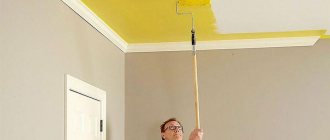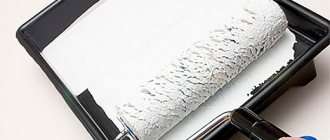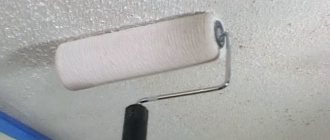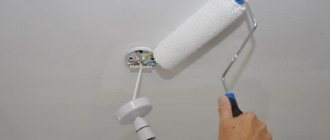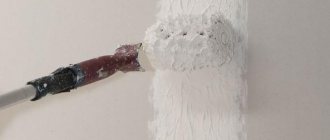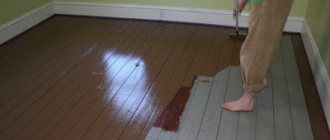Some may think that painting a wooden floor is a simple matter that does not require special skills and knowledge. It would seem that you bought paint and a brush or roller and you can get to work. It should be noted that this approach is absolutely wrong. In order for a wooden floor to have a beautiful appearance, it is necessary to pay due attention to the entire painting process, starting with the selection of tools and paint, ending with checking the quality of the work done.
Necessary tools for painting
First of all, we start by selecting the necessary tools. High-quality floor painting requires the presence of: paint brushes of different widths, rollers, a spatula, a painting tray, a chisel and masking tape.
When choosing a paint brush, you should opt for the so-called “flutes” - flat brushes of different widths. They are used to process floor edges, baseboards, corners, and other surface areas that are difficult to reach with a roller.
It is better to carry out the main part of the painting work with a roller - this will not only speed up the process, but will also allow you to apply the paint in even layers. It is best to use rollers with short naps, as too long naps will result in a rough or uneven floor surface.
Masking tape, or tape, is used to prevent paint from getting onto surfaces that are not to be painted. Its main feature is that after removing the tape, no traces remain on the sealed area.
To make it more convenient to put paint on the roller, you need a paint tray. As a rule, these containers have a raised bottom on one side, beveled at a slight angle, which has a relief surface, which allows you to remove excess paint from the roller.
To achieve a smooth surface of the wooden covering, it is necessary to remove excess knots on the boards using a chisel. A spatula will be necessary if you need to fill existing cracks.
Paint selection
The most important aspect when painting a wooden floor is the choice of paint type. Building materials stores offer a wide range of these products, so it’s important not to go wrong. Floor paint must have a high level of resistance to chemical and mechanical stress and not be susceptible to abrasive wear. When deciding which paint is best to purchase, you need to take into account the following floor features:
- the type of wood it is made from;
- conditions in which the surface will remain (air humidity, intensity of mechanical load, antistatic);
- presence of previous coating (varnish or paint).
It is best to use oil paint, alkyd enamel, alkyd and acrylic impregnation or alkyd varnish for a wooden floor. If the floor is new, then it is best to use acrylic or alkyd impregnation, but for a previously painted surface you need to use oil paint or alkyd enamel. It should be noted that the service life of enamel is about 6 years, while oil paint will last up to 3 years without losing its attractiveness.
You need to buy paint from one batch, so before you go to the store, you need to calculate how many cans you will need for the entire floor. Typically, 200 grams of paint are consumed per square meter of wooden floor, and you also need to take into account how many layers of painting will be done.
Ways to paint a wooden floor
There are several options for painting the floor, the choice of which will depend on the condition of the floor and the desired final result.
First way. Suitable for floors that have no visible defects, it is the simplest and fastest. First, the wooden floor is covered with drying oil or primer, after which it is given 2-3 days to dry. Next, the first layer of paint is applied, which dries for several days. When the surface is completely dry, apply a second layer. It may take 4 days to a week for the second layer to dry completely.
Second way. Used for floors that have cracks, gaps between boards or other imperfections. The preparatory stage consists of applying drying oil or primer, which dries well. After this, the floor surface is putty using a special oil putty, which should be the same tone as the floor. The putty areas dry and are sanded, after which the procedure is repeated. Before painting, problem areas of the floor are primed and painted several times until the putty is visible. Next, two layers of paint are applied alternately, as described in the first method.
Third way. This painting option is characterized by high labor intensity and complexity of the finishing stage of work, which can be performed using two methods.
- According to the first method, the floor surface is covered with drying oil, dried and putty several times, with each layer of putty thoroughly sanded down. After this, the floor is puttied for the last time, a primer is applied and the surface is painted in three layers.
- The second method is that after the first layer of putty has been cleaned, the next mask-like layer of putty is applied to the surface of the wooden floor, on which tightly stretched gauze is applied and embedded in it. The surface dries, after which the putty is applied a third time, it is cleaned, primed and painted in three layers.
Painting technology
Regardless of the method, painting the floor consists of a certain number of steps, the sequence of which must be followed. First of all, it is necessary to carry out the preparatory stage, and only then begin painting.
- If the surface has previously been waxed, it must be removed, as it will interfere with the paint drying. A good remedy would be laundry soda diluted in water (7-8 liters of liquid are needed per glass of soda).
- Grease stains from the floor can be easily removed with white spirit
- Use a spatula to scrape off old, peeling paint.
- If the boards are loose, they must first be nailed down, and the nail heads must be driven in to a depth of 3-4mm.
- Using a chisel, you need to clean out the knots that are on the surface.
- Having previously removed the remaining paint, sand and other debris, it is necessary to prime the cracks between the boards and the places where the old paint has peeled off or worn off. It is better to use drying oil.
- If the cracks are quite wide, then you need to use tow or rope and, after soaking them in a 15% aqueous adhesive solution, fill the holes.
- To eliminate cracks, you can also use sawdust putty, which is prepared from sifted fine sawdust and oil putty.
- The putty must be applied with a spatula, moving it perpendicular to the surface. The first layer of putty is used to fill and level the cracks.
- When the first layer is completely dry, large irregularities are sanded, after which continuous puttying is carried out using a wide spatula. The spatula must be kept parallel to the boards while working.
- The next step is to sand the surface. After sanding, the surface of the wooden coating is cleaned of dust and primed with drying oil or oxol. The primer must be given 2-3 days to dry completely.
- Before starting work, the paint must be poured out of the cans and mixed until a mixture of one tone is obtained.
- The paint must be thoroughly mixed so that there are no lumps or clots.
- It is necessary to stick masking tape on the surface of the wallpaper - this will help prevent paint from getting on them.
- You need to start painting from the baseboards, using a small brush.
- Using a brush, you need to pick up a small amount of paint on it, getting rid of its excess by squeezing the brush against the edges of the tray or jar.
- Wood floors should be painted in the same direction as the grain of the wood.
- The paint is applied in thin layers, because thick layers begin to swell over time.
- The brush should be held at a slight angle relative to the surface, slightly pressing it to the floor.
- When painting the floor with a roller, you must first wring it out. Using a special paint tray, excess paint can be removed on a textured surface. Movements with the roller must be performed away from you, without lifting off the floor.
- If the floor has been painted before, one coat of paint may be sufficient.
- New wood floors require two coats of drying oil or primer and 2-3 coats of paint.
- The second coat of paint is applied only after the first has completely dried.
- In order to remove any remaining drying oil or oil on the surface, the floor must be wiped with warm water for a week after drying. You can add vinegar to the water, but you cannot use soap, soda or powder, as they will damage the paint.
Read also: How to use a drill for a woman
Paint check
After the last coat of paint has been applied, the surface must be allowed to dry completely, which usually takes several days. To check whether the floor is dry, you can use a fairly simple method: just press your finger or a piece of paper onto the painted surface; if it does not stick, you can safely walk on the surface.
After completing the work, you need to pay attention not only to whether the paint has dried or not, but also to the quality of the paint. The floor surface should not show through the lower layers of paint, stains, wrinkles, drips, marks from a roller or brush. If such defects are present, another layer must be applied.
An important detail in the interior of any home is the flooring. The floor in the house affects the overall perception of the room more than other elements, so its design is given no less importance than the arrangement of walls and ceilings. Recently, leading positions have been occupied by floorings, which, as a rule, are decorated with paint. You can do the painting yourself at home, but before you begin, you should learn all the intricacies of the process.
Which roller to choose for painting the floor?
Which roller is better for painting the floor?
Buy with the (letter) marking “VMP”.
Manufacturers of rollers, in this regard, have made it easier for the user to make a choice, with the very same marking, it is enough to be able to read it (the marking).
The letter “B” means that the product is a roller, and not something else.
The letter “M” is the material from which the roller is made, in our case “M” means fur.
And the last letter is the purpose of the roller (that is, on what surfaces it is best to use it).
The letter "P" stands for floors.
Select the size of the roller individually; a lot depends on the floor area.
Paint rollers, including floor rollers, are produced in strict accordance with GOST, namely GOST 10831-87.
GOST, although from 1987, is still valid.
Fur rollers are much more durable than foam rollers, and the quality of painting will be at the same level.
Be sure to buy a paint bath like this for your roller:
The baths are also of different sizes, like the rollers, that is, one is matched to the other, you can immediately take a roller + bath set.
There is a corresponding regulatory document:
It defines several types of rollers, depending on the type of surface to be painted. If you paint the floor with paint, then you need to opt for VMP type rollers:
When choosing we take into account:
Source
What may differ in the design of the rollers?
Despite the simplicity of the tool, there is still a certain classification of rollers. First of all, this is due to the dimensions of the drum, which in diameter can be:
The handle of the instrument is called a clasp. Its length is usually proportional to the diameter of the drum and can be from 150 to 500 mm. The longer the handle, the easier it is to do the job, especially at height.
The importance of choosing a tool by size
The diameter and length of the drum greatly influence the operating speed. When wondering which roller is best to paint the ceiling, here, firstly, you need to be guided by the size of the area. The larger the diameter of the drum and its length, the larger the plane it will capture at a time. However, it must be taken into account that the large drum collects a large amount of liquid. Naturally, such a chosen tool becomes harder to use. If, for example, you choose a drum length of 200 mm, holding such a tool suspended is not tiring, but you will have to apply more stripes. A roller with a drum length of 300 mm will do the job faster, but your hand will get very tired. You can simplify the work by lengthening the handle, which will eliminate the need for using a stepladder when painting the ceiling with a roller.
Secondly, when deciding on the choice of tool, you must be guided by the very shape of the ceilings. Multi-level structures are equipped with various boxes, canopies and other elements. They form hard-to-reach areas where it is difficult to handle with a regular roller. There are two options for accessing such places: with a special roller or a paint brush. However, the second tool creates visible stains, which is unacceptable for ceilings. The way out of the situation will be the additional purchase of small rollers equipped with a non-standard clasp.
Difference in drum upholstery
The second indicator that determines the choice of instrument is the drum cover. The upholstery can be natural or artificial. Which one is better to choose depends on the paint used and the type of surface to be painted.
The upholstery also differs in the way it is attached to the drum:
In order to save money, of course, it is more profitable to use a removable roller cover for painting the ceiling with water-based paint.
Which enamel roller is better?
In order to facilitate the process of coating the surface of walls with paint and varnish, a special tool is used. Here, an enamel roller is most often used, since it is a fairly inexpensive option that is perfect for repeated use, and also stands out for its low price and ease of use. Not everyone is familiar with the types of these devices, as well as the procedure for choosing them, which is why you will need to consider the general rules.
Natural fur roller
If you're looking for the perfect roller for working with oil paints and varnishes, this is it. In addition, a tool made from natural fur copes well with water-based and dispersion paints. The “coat” of the roller perfectly absorbs the paint and distributes it evenly over the surface of the walls, floor or ceiling. Such a roller is highly wear-resistant, but on the condition that it will not be used to work with lime paints, since they will destroy the natural material.
Features of choosing a roller for enamel
To determine which type is best to choose for the upcoming work, you will need to familiarize yourself with some of the nuances associated with the choice of this building element:
It is necessary to understand that to process corners, you will need a special device that will allow you to easily apply a primer or dye in a hard-to-reach place on the surface.
Important! In order not to experience difficulties when purchasing this product, it is recommended to seek help from a specialist if you do not have an accurate idea of the work to be done and how to use the roller.
Fur coat material
This version of the construction painting tool differs markedly in the type of coat used. In practice, you can select the following products:
We should not forget about the presence of textured types, which are used to apply a special pattern or design to the surface.
Cylinder width and size
Among other things, there is a difference in the size of the cylinder. Typically, mounts are provided with sizes of 6, 8 and 12 millimeters. In terms of width, these structural elements are available in different ranges, starting from a standard 200mm roller. And ending with 500mm cylinders. This allows you to optimally select the required type of device for the upcoming work.
Bracket Attachment
Another difference between this device is the type of fastening. In practice, there are two main options. First of all, we should highlight the standard type of roller with one bracket, which is fixed on one side. There are also separate versions of the rollers, which use a double bracket that securely fixes the cylinder on both sides.
Important! When choosing such a device, it is recommended to choose only those types of devices that allow multiple changes of the cylindrical roller.
At the moment, various types of tools can be used to carry out measures for applying paint and varnish material to the surface. This allows you to choose the optimal device that is suitable both in price and ease of use. Most often, the choice falls in favor of rollers. This is not surprising, since such varieties have a relatively low cost, the ability to be used repeatedly, and in addition, they allow you to easily do everything necessary even for a person who does not have practical experience in contact with liquid dyes and primers.
Source
Pros and cons of working with a roller
Using a roller to paint any walls has many advantages over classic brush painting:
However, there are some disadvantages to this tool:
However, if you take into account all the features of working with the tool, you can save money and paint everything that needs to be painted.
The range of rollers is quite large: for each operation you can select a tool of a certain type and design of the element being painted.
There are several main types of rollers for painting ceilings and walls:
According to their purpose, rollers are divided into:
Each option is selected for specific tasks, so you cannot purchase one roller for all surfaces.
Which roller to paint the floor with enamel
Some may think that painting a wooden floor is a simple matter that does not require special skills and knowledge. It would seem that you bought paint and a brush or roller and you can get to work. It should be noted that this approach is absolutely wrong. In order for a wooden floor to have a beautiful appearance, it is necessary to pay due attention to the entire painting process, starting with the selection of tools and paint, ending with checking the quality of the work done.
Necessary tools for painting
First of all, we start by selecting the necessary tools. High-quality floor painting requires the presence of: paint brushes of different widths, rollers, a spatula, a painting tray, a chisel and masking tape.
When choosing a paint brush, you should opt for the so-called “flutes” - flat brushes of different widths. They are used to process floor edges, baseboards, corners, and other surface areas that are difficult to reach with a roller.
It is better to carry out the main part of the painting work with a roller - this will not only speed up the process, but will also allow you to apply the paint in even layers. It is best to use rollers with short naps, as too long naps will result in a rough or uneven floor surface.
Masking tape, or tape, is used to prevent paint from getting onto surfaces that are not to be painted. Its main feature is that after removing the tape, no traces remain on the sealed area.
To make it more convenient to put paint on the roller, you need a paint tray. As a rule, these containers have a raised bottom on one side, beveled at a slight angle, which has a relief surface, which allows you to remove excess paint from the roller.
Paint selection
The most important aspect when painting a wooden floor is the choice of paint type. Building materials stores offer a wide range of these products, so it’s important not to go wrong. Floor paint must have a high level of resistance to chemical and mechanical stress and not be susceptible to abrasive wear. When deciding which paint is best to purchase, you need to take into account the following floor features:
It is best to use oil paint, alkyd enamel, alkyd and acrylic impregnation or alkyd varnish for a wooden floor. If the floor is new, then it is best to use acrylic or alkyd impregnation, but for a previously painted surface you need to use oil paint or alkyd enamel. It should be noted that the service life of enamel is about 6 years, while oil paint will last up to 3 years without losing its attractiveness.
You need to buy paint from one batch, so before you go to the store, you need to calculate how many cans you will need for the entire floor. Typically, 200 grams of paint are consumed per square meter of wooden floor, and you also need to take into account how many layers of painting will be done.
Ways to paint a wooden floor
There are several options for painting the floor, the choice of which will depend on the condition of the floor and the desired final result.
First way. Suitable for floors that have no visible defects, it is the simplest and fastest. First, the wooden floor is covered with drying oil or primer, after which it is given 2-3 days to dry. Next, the first layer of paint is applied, which dries for several days. When the surface is completely dry, apply a second layer. It may take 4 days to a week for the second layer to dry completely.
Second way. Used for floors that have cracks, gaps between boards or other imperfections. The preparatory stage consists of applying drying oil or primer, which dries well. After this, the floor surface is putty using a special oil putty, which should be the same tone as the floor. The putty areas dry and are sanded, after which the procedure is repeated. Before painting, problem areas of the floor are primed and painted several times until the putty is visible. Next, two layers of paint are applied alternately, as described in the first method.
Third way. This painting option is characterized by high labor intensity and complexity of the finishing stage of work, which can be performed using two methods.
Painting technology
Regardless of the method, painting the floor consists of a certain number of steps, the sequence of which must be followed. First of all, it is necessary to carry out the preparatory stage, and only then begin painting.
Paint check
After the last coat of paint has been applied, the surface must be allowed to dry completely, which usually takes several days. To check whether the floor is dry, you can use a fairly simple method: just press your finger or a piece of paper onto the painted surface; if it does not stick, you can safely walk on the surface.
After completing the work, you need to pay attention not only to whether the paint has dried or not, but also to the quality of the paint. The floor surface should not show through the lower layers of paint, stains, wrinkles, drips, marks from a roller or brush. If such defects are present, another layer must be applied.
An important detail in the interior of any home is the flooring. The floor in the house affects the overall perception of the room more than other elements, so its design is given no less importance than the arrangement of walls and ceilings. Recently, leading positions have been occupied by floorings, which, as a rule, are decorated with paint. You can do the painting yourself at home, but before you begin, you should learn all the intricacies of the process.
Criterias of choice
Many people wonder: which roller to choose for painting the ceiling or walls. There are eight main aspects to consider when choosing a roller:
Don't forget to purchase a cuvette. This small trough allows you to apply paint evenly and remove excess paint from the roller. It is reusable, so it will be useful for further repairs.
Dimensions
The rollers differ not only in design, but also in size. The instruments are classified according to their sizes:
There are also separate rollers for working with bitumen and structural paint.
Foam rubber
The cheapest option, suitable for water-based paints for interior work. Its main drawback is its low resistance to aggressive compounds. The foam roller is not suitable for oil and alkyd paints.
Velours
The velor roller is chosen by those who value quality. It allows you to create smooth surfaces if the painter is professionally trained. If there is none, it’s worth practicing, as all the defects will stand out.
Fur varieties are used for applying enamel, oil, latex paints and silicates. The shorter the pile of such a fur coat, the smoother the surface will be. These rollers are considered classic, since their history goes back to the past, when our grandparents painted fences and walls of houses with them.
Polyamide thread
Rollers with threads instead of a coat allow you to apply paint quickly, but not too carefully. In this case, the movements should not be sharp, since paint tends to splash from the roller.
Peculiarities
Any type of repair work has its own characteristics, and painting the floor is no exception. Most often, wooden flooring is chosen as flooring. Before you buy paint or varnish for the floor, you need to understand the origin of the existing floor covering. The material used for its manufacture is important when choosing paint or varnish, as well as the means with which the preparatory work will be carried out. You can paint the floor using acrylic, oil, wear-resistant and universal rubber paints.
It is necessary to take into account the characteristics of the room where painting work is planned. The intensity of use, exposure to external factors, average temperature and humidity are very important when selecting paint, since the service life of the painted surface will depend on its properties. If the surface itself has been previously painted, then it is necessary to determine the degree of compatibility of the used paint with the new product.
If the goal is not renewal, but the application of a new layer, then you need to either prime or treat the surface with a special compound before applying the decorative layer.
Content:
If you need to paint the walls and floor or whitewash the ceiling, then the first assistant for any master will be a paint roller. Of course, you can always use a brush and even a special aerosol, but only a roller applies the paint to the surface evenly and carefully, layer by layer. Therefore, even a non-professional painter can use this simple, convenient and economical tool to paint surfaces on his own.
Anatomy of the cushion
Why are there so many different fur coats?
Sizes matter
The size of the roller also determines what kind of work they can be used for. For example, for painting the outer wall of a house, an exterior paint roller is suitable, which can quickly handle such large volumes of work. On the other hand, if you need to carefully apply a protective coating or paint in hard-to-reach places, for example, at a joint or corner, then use a mini roller. In this case, large sizes are more likely to hinder accurate and precise work than to help.
So, according to the size and length of the pile, rollers are divided into the following categories:
What to paint with?
Today, there are various types of paints and varnishes that can be selected for both wooden flooring and concrete floors. There are two types of products that can be used to cover the floor: colorless and opaque. Clear varnishes are great for wooden surfaces. They are durable and fade resistant, and dry quickly. Decorative varnishes have many tones, thanks to which a wooden surface can be given a beautiful shade without blocking the structure of the wood. Beech, oak and other expensive flooring have a beautiful structural pattern, and a varnish with a translucent or transparent consistency will perfectly highlight it, give it shine and protect it from moisture.
It is worth remembering that the varnish is not resistant to various mechanical damage, and therefore it is better not to cover surfaces in rooms with high traffic. Otherwise, it is worth applying additional impregnations.
Do not use this product on flooring made of soft wood (spruce, pine). It is better to treat them with paint that maximally protects the surface from mechanical damage.
What else do you need to know about this tool?
Professionals pay special attention to the type of attachment of the roller to the metal handle.
Professionals pay special attention to attaching the roller to the metal handle
There is a tool with three types of systems:
- clasp;
- frame;
- special.
The clasp securely fixes the roller, making the mini or midi roller reusable. You can only change the fur or sponge attachment. The groove at the end of the metal clasp and the lock ensure quick removal of the roller, its replacement, and the imparting of other characteristics to the working surface.
The frame system has a special roller design, which is created in such a way that there is a plastic bearing, plastic plugs and a lock inside. The fur or foam coat is fixed by a special mechanism with a rotation element and limiters.
Which paint is better?
Paints of various colors are divided depending on the chemical composition into acrylic, oil, wear-resistant and rubber:
What is better to apply wood varnish - with a brush or a roller?
There are four main ways to varnish wooden floors: brush, roller, trowel and spray.
1. A spray bottle is a purely professional means of applying varnish to floors. With its help you can cover the floor with a large amount of varnish. The most appropriate use is to obtain a super glossy finish. To work with a spray gun, you need a lot of experience. The amount of varnish is huge, the cost of an error is sky-high, and as a result, the cost of work is high.
2. Varnishing with a spatula is also highly professional. Its use involves applying multiple layers with minimal varnish consumption for each. The application is specific, technologically stretches the process for a long time, is labor-intensive and also results in a higher price. An amateur who has never worked with the above tools will not be able to perform varnishing at the proper level.
Color solutions and decor
Gone are the days when only one color was used to paint a floor. Brown paint and several of its shades were produced specifically for wooden flooring. Today, manufacturers produce a wide color palette, thanks to which you can choose absolutely any shade. Water-based paints are especially distinguished by their color range. There are both ready-made options and those that can be given the desired shade using a special colorant. White paint is the base, to which a certain amount of the desired color is added. In order to get the desired shade of paint, you can add several colors.
Matte varnishes also have different colors and shades. With their help, you can give any wood flooring a touch of noble wood. Painting the floor covering can be done using one color or shade, evenly distributing the product over the entire surface. There are special stencil devices with which the surface of the old floor is transformed by applying a pattern. The technology is simple: a stencil with a cut out pattern is applied to the floor surface, and paint is applied to the open areas.
You can use either a sponge or a roller as a tool.
Differences between synthetic drum covers
Materials made of polymer fibers or foam rubber are used as synthetic cushion covers.
Polyamide upholstery
This fur coat is characterized by uniform coloring of the surface. Its advantage lies in its excellent paint retention. When working with a tool at height, liquid from the polyamide upholstery does not flow down the handle. If we talk about water-based or acrylic painting of a flat surface, then a roller with such a coat is a good choice.
Polyacrylic fur coat
Running your hand over a drum with such upholstery, you might think that it is real wool. Polyacrylic coat is ideal for working with water-based paints or low solvent concentrations. Unlike polyamide upholstery, a roller with a polyacrylic coat is cheaper, but the tool is inferior in terms of service life. Polyacrylic coat is well suited for water-based or acrylic paint.
Thread pile
There are special types of drum covers with long pile. The material is made of polyamide or polyacrylic threads. The peculiarity of such a fur coat is that it leaves visible marks resembling patterns on the painted surface. The disadvantage of thread upholstery is the strong splashing of liquid water-based or acrylic paint, which requires slow and careful rotation of the drum.
Polyester upholstery
Such a fur coat can be confused to the touch with lining insulation for clothing - padding polyester. Polyester fiber absorbs liquid well, preventing it from flowing down the roller handle. This is very convenient when painting a ceiling with water-based or acrylic paint. The advantage of polyester upholstery is that there are no streaks on the painted surface. Of course, such a fur coat wears out quickly, but the low cost compensates for this drawback.
Foam upholstery
The soft and porous material absorbs liquid perfectly, but it is not suitable as a roller for water-based paint or an analogue on acrylic. If there is a strong accumulation, leaks will begin along the roller handle. In addition, the quality of the painted surface will be poor. Water-based or acrylic paint will leave small bubbles. Over time, they will dry out in protruding drops or simply burst, leaving a round mark. However, a foam roller is well suited for processing a textured surface, such as plaster stucco. You can, of course, paint it with a brush, but it’s faster to treat a larger area with a roller.
Polymer drum coating
Textured rollers are designed for applying designs. They are often used to update old wallpaper with water-based paint. Large areas cannot be painted with textured rollers. The polymer upholstery is statically attached to the drum.
Work technology
Floor painting, like any other job, has its own technology. The final result depends on a competent and consistent approach to this type of activity. Before you begin the process, you need to prepare the tools that may be needed both during the preparatory work and for painting the floor:
Surface preparation
Preparatory work is carried out based on the condition of the coating surface. If the flooring is new, then you need to sand the surface well using a sanding machine, then remove dust and debris. If the coating is old, then first remove the paint layer using either a mechanical (using a hair dryer) or chemical (solvent) cleaning method. The resulting cracks are puttied, and after drying the surface is leveled.
If the coating is to be varnished, then there is no need for a primer. Such floorings are treated with special impregnations that protect the wood from mold, fungi and accidental fire. To prepare the floor for painting, use drying oil or a special primer, which gives the flooring antiseptic properties and prepares the surface.
A smooth and level floor with good adhesive properties will greatly facilitate the adhesion of paint to the flooring.
How to paint?
After preparation, you can start painting the floor in the apartment. There is a certain sequence for this stage of work. Before painting, the composition must be thoroughly mixed in a jar to remove clots, and this procedure is carried out regardless of the color (black, white, colored) of the paint. Then you can begin painting the surface adjacent to the walls, starting on the opposite side of the entrance. It is more convenient to do this with a small brush, since it will not be possible to thoroughly paint every corner with a roller.
After applying a layer around the perimeter, you can begin painting the central part of the floor. The applied layer of paint must dry completely, and only then can you begin installing the skirting boards. In order not to stain wallpaper or other facing materials on the walls, you need to cover the part adjacent to the baseboards with masking tape or other available means. Next, you can start painting the baseboards using a narrow brush. After the first layer has dried, a second layer is applied to the baseboards. After waiting the required time for it to dry on the baseboards, you can begin applying paint to the central part of the surface.
When the painted surface is completely dry, you need to prepare the floor for use by washing it thoroughly.
Painting a wall with a roller
Wallpaper for painting does not lose its relevance, so you should choose a special version of the tool for it. Deciding which roller to paint the wallpaper for painting depends on the type of base and the type of paint used. The process consists of main stages:
Each stage is important to obtain the desired result.
Preparing for work
Before painting, it is important to prepare the surface. It is necessary to eliminate all defects: chips, cracks, unevenness. This can be done with sand-cement mortar and putty. If it is not possible to level the walls, they can be covered with plasterboard. It solves the problem of unevenness and insulates the structure of the building. To protect baseboards and trim, you need masking tape.
Before starting painting work, you should prepare everything necessary for effective work. In addition to the basic elements (paint and roller), you will need:
All surfaces of furniture and other objects located in the room should be covered with protective film. If possible, care should be taken to ensure ventilation. It will remove toxic fumes resulting from the evaporation of chemicals.
Painting work
Work should begin by pouring the dye into the container. The paint should be diluted according to the manufacturer's instructions. Any experiments can negate all the efforts made: the paint may become too liquid or thick.
Then the roller is lowered into the working composition for impregnation. The tool is then rolled over a grooved tray to remove excess.
Visually, the entire surface should be divided into several zones. When processing large areas, it is advisable to roll the roller diagonally. This technology allows the composition to be evenly distributed by covering the first layer with a second layer. You need to roll it out so that the layer is thin. Professionals believe that it is better to make three thin layers than one thick one.
Do not linger in one place to avoid swelling of the paint and changing the surface texture from smooth to rough. If an area is skipped, it is better to wait until the surface dries. Only after this can you begin re-painting.
Application technology
The technology of painting with a roller differs from the methods of applying paint with brushes. Coloring should begin from the top, moving down. Painting begins from the window for a more uniform application.
The square-cluster coloring technique is considered optimal for beginners. These are kind of tricks to make a large canvas piece by piece. It involves dividing the entire surface into 1 meter sections (0.7 m if necessary). The squares are filled in gradually. Work can be done horizontally or vertically.
After the first coat, streaks (the borders of the squares) may be visible, but they will quickly disappear after applying a second coat of paint.
The saturation of the coating depends on the number of layers. Paints of different composition require individual application: acrylic and water-based paints should be applied in 3-4 layers with an interval of 12 hours, oil paints can be applied in 2-3 layers.
Therefore, before painting, you should study the instructions for using a particular composition.
End of work
The remaining paint after work is isolated from direct contact with air. The water-based emulsion may dry out in 2-3 days. Oil paints also do not tolerate such contacts and lose their properties, so they need to be placed in a jar with a tight-fitting lid. Do not add paint to a can of untouched paint. Such mixing will negatively affect its quality.
Masking tape must be removed from trims and baseboards. This must be done before the painted layer has completely dried so that there is no streak left. After the paint has completely dried, you can remove the film from the furniture and throw away the used cape.
You can install lamps, sockets and switches on the painted surface.
Advice from professionals
There are several professional tips that can help you achieve the best results:
You will learn more about how to properly paint a floor in the following video.
It seems that there is nothing complicated in choosing a paint roller, but in fact it is an important element for painting that requires special attention. The roller determines how the paint will adhere to surfaces, how convenient it will be to paint, whether it is suitable for reuse, and so on. Not only the dimensions of the handle and the roller itself are important, but also the materials that were used for it.
Therefore, for its readers, “Dream House” has prepared a full review that will help you choose a high-quality paint roller and easily cope with painting any surface and any type of paint.
How to choose a paint roller
Content:
What could be easier than painting a wall with a roller? I dipped it in the paint, shook it off a little and began to move it along the wall. Of course, if you follow this scheme, then there is nothing surprising in stains, splashes and the presence of unpainted areas.
What does a quality result depend on? Of course, the list of reasons includes both the skill of the master and the quality of the paint itself. One of the most important conditions for an evenly painted surface is the correct choice of roller for the job. Here is a clear example: after painting the ceiling, small bubbles formed on its surface, which over time began to peel off. Why? The reason is the foam roller, which is not recommended for such work. Next, we will look at what types of rollers and for what surfaces are best used.
What types of rollers are there for painting surfaces?
Paint rollers types and sizes
You can use different rollers at home. First of all, they can be used for walls, floors and ceilings. The following paint rollers are classified according to their purpose and type:
To understand all their differences, you should familiarize yourself with each type separately.
Foam rollers
These inexpensive synthetic polyurethane rollers do not last long and are not suitable for active formulations. In particular, they are used for priming and painting surfaces with water-dispersion paints. But they are easy to use and affordable. They can be washed and dried quickly. Fur coats can be easily changed, so this option is quite practical and helps save money. Thanks to the foam rollers, the paint is applied evenly and accurately. You can easily paint on the sides and in hard-to-reach places if the roller size allows.
Polyacrylic (velor) rollers
This type is ideal for paints and varnishes, water-based and oil-based paints. Despite the light fleecy texture, no fluff from the roller remains on the surface. The paint is applied neatly and evenly thanks to the velor roller. It can be used on ceilings, walls and other smooth surfaces.
Fur rollers
They are made from natural sheepskin or polyester-based faux fur. The roller has a hard fleecy surface, so it is perfect for enamels and oil paints. The length of the pile should be selected depending on the type of surface. If the wall is not smooth, but rather porous or rough, then you should pay attention to a roller with long pile. They can be used to paint walls, floors and other surfaces.
Fur roller for painting
Polyamide rollers
There are different types of nap rollers, and polyamide is one of this category. They have the longest pile, so they are suitable for painting rough surfaces such as putty, drywall and the like. They are relevant for water-based enamel paints.
Textured rollers
If you are not satisfied with just a smooth surface, but do not want to use wallpaper, then you should pay attention to embossed rollers for decorative plaster, wet putty, and the like. They have a design similar to all conventional rollers, but they do not have a soft coat, but only a rubber base with some kind of pattern. There are many different options that you can choose according to your taste and preferences.
Textured rollers for decorative plaster
Roller with a pattern for walls
Wallpaper rollers
This type of roller is used for wallpapering. During wallpapering, air may be trapped under the canvas; eventually, it must be removed from there. A special roller with a fairly hard surface works wonderfully for this. With it, smoothing the wallpaper will not take much time. After use, it can be easily washed and dried quickly.
Frame rollers
These rollers are called frame rollers because they are made differently from all the others. They don’t just wear a ready-made fur coat. There is a completely finished frame on which the soft covering is attached. When using them with a roller, less paint is absorbed. Their cost is low, but they are easy to use.
Facade rollers
They are distinguished by long pile and the presence of a special intermediate padding, which slows down the rotation speed of the roller. This contributes to better quality painting and the absence of splashes during painting.
What to look for when choosing a paint roller
Which roller for which paint?
When you come to the store, it is difficult to analyze the quality of the roller solely by its appearance. Not all sellers have personal experience in using paint rollers, so they can only advise on manufacturers, price and similar characteristics. The paint roller should be chosen correctly so that it is convenient to use, and the resulting result fully satisfies expectations.
Here are some tips to help you choose the perfect paint roller:
- When painting the ceiling, you should choose a tool that is not heavy, so that your hands do not get tired in the first couple of minutes. Ideally, rollers with a long handle are suitable for the ceiling so that you can paint while standing on the floor, but they weigh a lot and are more suitable for professional painters.
- For walls, the weight of the tool is also significant. Take, for example, a fur roller. After impregnation with paint, it becomes even heavier, and it is very difficult to use it for a long time without good physical preparation.
- The colors of the fur coat can also be different. It is much more convenient to work with a white fur coat or any other. Rollers with dark piles have the ability to fade over time, and the long pile of low-quality rollers can remain on the wall along with the paint.
- Make sure that there are no seams on the fur coat, because this will cause discomfort during painting. Such rollers leave marks on the surface. Of course, they can be removed, but to do this you will have to apply another layer of paint, and maybe more than one.
- Don’t be shy to try each handle for strength. You can press on the roller to see how hard it is and whether it bends during use. Also, the handle itself should be comfortable; for this you need to hold it in your hand.
The most important thing when using a paint roller is that the painting process is uncomplicated, and the surface turns out well painted even after the first coat. At the same time, I want the cost of the tool to be low. A huge selection of options in construction stores fully fulfills all the requirements of customers, so feel free to go looking for your roller, armed with our advice.
Comparison of different types of rollers
Optimal selection of roller is one of the main factors determining the quality of varnishing. Often the choice is between polyamide and polyester based equipment.
There are the following arguments in favor of polyamide:
- Polyester-based rollers have a much faster decline in performance compared to equipment with a “coat” made of polyamide. In particular, this is manifested by a reduction in the volume of varnish applied, which means lower productivity per square meter of surface treated. This also means that polyester tools need to be replaced more often.
- The minimum thickness of the dried varnish layer should not be below 80 microns. This indicator can be obtained if the material application density is at least 300 g. per square meter. At the same time, polyester-based rollers allow the density of one layer to be up to 100 g. per square meter, while a polyamide tool is about 120 g.
Please note: a good indicator of the spreadability of the paint and varnish material is an important factor ensuring a high-quality result. If too little varnish is applied, the so-called orange peel, sagging, and uneven glossy effect may appear on the surface.
Thus, these factors allow us to conclude that polyamide tools have higher performance: their use is more justified both for financial reasons and from the point of view of high-quality work.

